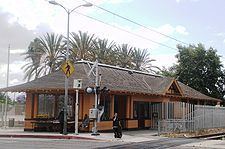Built 1904 LAHCM # 36 Area 1 ha Added to NRHP 15 March 1974 | NRHP Reference # 74000523 Opened 1904 Architectural style Victorian architecture | |
 | ||
Location 1686 E. 103rd Street, Watts, Los Angeles, California Similar Pacific Electric Railway, Pacific Electric Railroad, Pacific Electric Building, Second Church of Christ - Sc, Subway Terminal Building | ||
3365 watts station dr
Watts Station is a train station built in 1904 in Watts, Los Angeles, California. It was one of the first buildings in Watts, and for many years, it was a major stop for the Pacific Electric Railway's "Red Car" service between Los Angeles and Long Beach. It was the only structure that remained intact when stores along 103rd Street in Watts were burned in the 1965 Watts Riots. Remaining untouched in the middle of the stretch of street that came to be known as "Charcoal Alley", the station became a symbol of continuity, hope, and renewal for the Watts community. It has since been declared a Historic-Cultural Monument and is listed on the National Register of Historic Places.
Contents
- 3365 watts station dr
- Map of Watts Historic Train Station 1686 E 103rd St Los Angeles CA 90002 USA
- Killsonic watts station meet me at the metro
- Construction and operation as a Pacific Electric station
- Colorful and violent history
- Symbol of hope along Charcoal Alley
- Historic designation and restoration
- References
Map of Watts Historic Train Station, 1686 E 103rd St, Los Angeles, CA 90002, USA
Killsonic watts station meet me at the metro
Construction and operation as a Pacific Electric station
Watts was built on the old Rancho La Tajuata. In 1902, the family of Charles H. Watts, for whom the community was later named, sought to spur development of the rancho by donating a 10-acre (40,000 m2) site to the Pacific Electric Railway. Watts Station was built on the site in 1904, serving for more than 50 years as a major railway depot and stop for the Pacific Electric's "Red Car" service between Los Angeles and Long Beach. It was located at a major junction, where lines to San Pedro and Santa Ana branched off from the main line to Long Beach. The station is a single-story, 2,200-square-foot (200 m2), wood-frame structure divided into three rooms. It was one of the first buildings erected in Watts and is one of the few remaining from its early years. It also served as a model for later depots built in La Habra, Covina and Glendora.
When the station opened, it drew people to the area, so much so that the community that grew in the area was initially known as "Watts Station." A vintage 1906 photograph of the station from the USC Digital Archives can be viewed here. Another classic image of the station from the collections of the Los Angeles Public Library can be seen here.
The building remained an active depot until passenger rail service was discontinued in 1961.
Colorful and violent history
From its beginning, Watts Station had a colorful and violent history. Incidents occurring around Watts Station in its early years including the following:
Symbol of hope along "Charcoal Alley"
In August 1965, the Watts Riots resulted in the destruction of buildings up and down 103rd Street—the main commercial thoroughfare in Watts. Watts Station was situated in the center of the one-mile (1.6 km) stretch of 103rd Street between Compton and Wilmington Avenue that came to be known as "Charcoal Alley" due to the widespread destruction. One observer recalled: "Both sides of 103rd Street were ablaze now. The thoroughfare was a sea of flames that emitted heat so unbearable that I believed my skin was being seared off." Another account of the riots along "Charcoal Alley" states: "On the third day of the Watts Riots, 103rd St. was burned to the ground." In the middle of the rubble and widespread destruction along "Charcoal Alley", the Los Angeles Times reported that "the train station was the only structure that remained intact when stores along 103rd Street burned during the Watts riots." The survival of the old wood-framed Watts Station, whether an intentional omission or a mere coincidence, resulted in the station becoming, as the Los Angeles Times put it, "a symbol of continuity, hope and renewal" for the Watts community.
Historic designation and restoration
Four months after the riots, the station was declared a Historic-Cultural Monument (HCM #36) by the Los Angeles Cultural Heritage Commission. It was also listed on the National Register of Historic Places in 1974. In the 1980s, after the station had been vacant for many years, the Community Redevelopment Agency spent $700,000 to restore the structure to its original exterior design. The station was re-opened in 1989 as a customer service office for the Los Angeles Department of Water and Power and a small museum of Watts history. Mayor Tom Bradley attended the dedication ceremony and said: "Those days of glory are going to return, and we are going to be at the heart of the action right here at the Watts train station."
In 1990, the Metro Blue Line resumed train service from Los Angeles to Long Beach along the old Pacific Electric right of way. Though the old Watts Station does not serve as a passenger platform or ticket booth for the new Blue Line, the trains do stop at a new "Watts Station", 103rd Street-Kenneth Hahn, on 103rd Street, at a location next to the old Watts Station. More than 87 motorists and pedestrians having been killed at Blue Line crossings since 1990, making it the deadliest and most accident-prone light rail line in the country.
